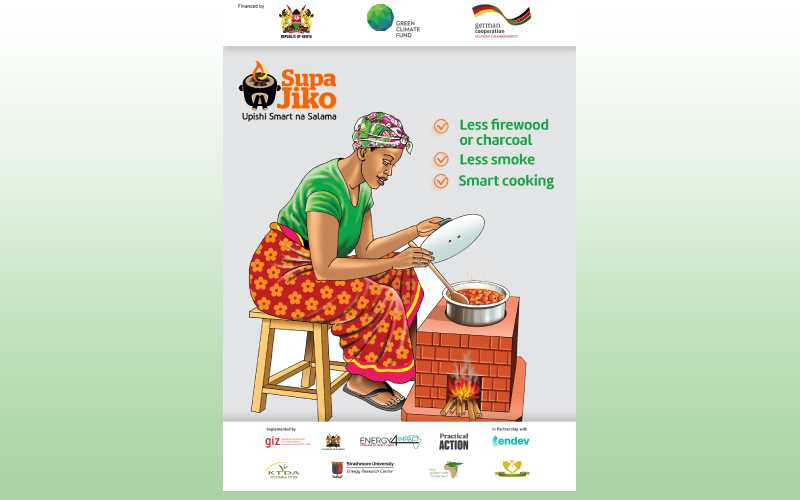
a variety of improved cooking stoves and fuels.
Data from the Kenya Household Cooking Sector Study 2019 shows that about 7.3 million households use the Three Stone Open Fire (TSOF) compared to about 4.7 million two decades ago. Thus, instead of more Kenyans adopting clean cooking, a bigger number is still stuck with this traditional mode. That not only contributes to an increase in the country's greenhouse gas emissions but also jeopardises the health of many.
Moreover, approximately, 70 per cent of households in Kenya still use a type of woodstove as their primary or secondary cooking stove, with a greater prevalence of 92 per cent in rural areas.
Solid biomass remains a common source of energy in Kenya used by an estimated 68 per cent of households. Therefore, Kenya needs to rapidly expand accessible clean cooking solutions given that only 30 per cent of rural households and 54 per cent of urban households currently use clean cooking technologies and fuels.
This is the current situation even as Kenya has an ambitious target of achieving 100 per cent universal access to modern clean cooking solutions by 2028, as a commitment to contribute to Sustainable Development Goal 7 (SDG7) and the Sustainable Energy for All (SEforALL) agenda.
Additionally, as a country, Kenya has committed to reducing its greenhouse gases by 32 per cent by 2030. Household cooking using firewood, charcoal and kerosene is a major contributor to Kenya's GHG emissions.
These national targets are yet to be realised due to the lack of an enabling environment; low access to finance for both businesses and consumers; and lack of affirmative policies to support the accessibility, availability and use of improved cooking technologies. For example, value-added tax on improved cookstoves and LPG negates the drive to promote clean cooking as more people need to be encouraged to adopt these solutions.
More than 38 million people in Kenya (or 80 per cent of the population) are at risk of household air pollution due to the use of solid fuels. Approximately 21, 560 deaths per year are attributed to this indoor air pollution. This figure is seven times the average number of deaths caused by road accidents.
Women and children are the most vulnerable to indoor air pollution caused by dirty cooking methods because they spend the most time in the kitchen.
Last year, the World Bank indicated that Kenya's adoption of clean cooking is at 20 per cent. This is according to the Tracking SDG 7, The Energy Progress Report.
Thus, more households should be enabled to adopt clean cooking for Kenya to meet its 2028 universal energy access target and mitigate climate change. This will also help reduce the diseases and deaths caused by indoor air pollution and release girls and women from the burden of collecting firewood for cooking needs, more especially in rural Kenya.
Rural women and girls are disproportionately affected by the burden of looking for firewood over long distances. Girls do so at the expense of their education, whereas women lose opportunities for social and economic development when they invest a lot of time in fetching firewood.
This means the country needs to intensify public awareness campaigns expounding the benefits of clean cooking solutions that include a variety of improved cooking stoves and fuels (LPG, biogas and bioethanol, among others. Kenya should also craft and implement policies that promote the uptake of clean cooking technology and energy.
The GCF/EnDev Project: "Promotion of Climate-Friendly Cooking"
The project is co-financed by the Federal Ministry for Economic Cooperation and Development (BMZ) and the Green Climate Fund (GCF), Kenya's Ministry of Energy (MoE). Currently, the project is implementing an innovative Improved Cookstoves (ICS) market transformation strategy in Kenya, and further improving global knowledge about ICS sector contribution to Nationally Determined Contributions (NDCs).
Stay informed. Subscribe to our newsletter
It will significantly increase the number of ICS users in Kenya particularly in peri-urban and rural areas. The proposed project aims to create self-sustaining ICS markets, leading to substantial climate change mitigation impacts in Kenya, i.e. direct project lifetime GHG emission reductions of 5.3 Mt of CO2eq. The project will also enable a total of 1.6 million households to adopt ICS, hence benefiting approximately 8 million people.
It is worth noting that, in July this year, in Kenya, the Ministry of Energy in partnership with the GCF/EnDev Project, launched a Behaviour Change and Communication (BCC) strategy for promoting clean cooking, which aims at increasing awareness of the benefits of clean cooking and encouraging the uptake of improved cooking solutions.
This represents a step forward toward 100 per cent universal access to modern cooking solutions and will in turn help create a self-sustainable market for Improved Cooking Stoves, and that will ricochet towards substantial climate change mitigation impacts.